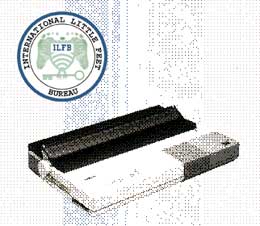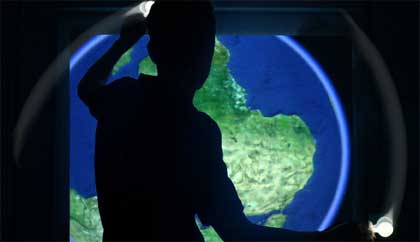[....]
 How about the Little Feet Bureau? What did you try to achive with that project? Did you intend to raise the attention to online surveillance? Which kind of audience did you have in mind when you developed the LFB?
How about the Little Feet Bureau? What did you try to achive with that project? Did you intend to raise the attention to online surveillance? Which kind of audience did you have in mind when you developed the LFB?
By now you can probably pick an overarching theme I'm working with. You know, growing up in Israel I always had regional maps around me, each one of them looked different... I managed to reach quite a grow up age without knowing what are the borders of my country. In a way I still don't. It has become my own private border conflict. That is why I'm so drawn to the internet and that is why I'm so interested in Postnationalism.
The Little Feet Bureau is concerned with exactly that - the tension between the Postnational tendencies of the web and the paranoid tendencies of national information agencies. Governments and national ideologies secretly surveil innocent internet traffic trying to project and justify their fears and construct fantastic narratives of terrorism, extremism and instability through bundeling of 'dangerous keywords'. For me this is the peak of the tension the core of the digital border conflict. Toshi Ozawa, David Nolen and myself have created the Little Feet Bureau, an independent agency providing surveillance services for different governments. LF's dot-matrix printers are personalized to the client's ideology and print accusation letters to suspect users based on these paranoid keyword narratives. Essentially, these are paranoia machines - embodying national fears and cultural segregation into computer algorithms.
Did we do it to inform and raise attention about online surveillance? I'm not sure. Actually, Little Feet was launched in an Upgrade! New York event we held in Eyebeam. The title of the event was: We Passion Power and Control: the dark desires of art under surveillance. We also had presentations by of in(security) and of Generative Social Networking (both worth a WMMNA post). When we opened it to discussion we asked exactly that - did we do that to educate? to inform? to raise attention? or was there another thing? There is a constant love/hate relationship between artists and power. On one hand we want 'to protest against them', 'to raise awareness', 'to reveal the injustices' but on the other hand we simply envy that power, we WANT to posses the power of surveillance, we protest against it both because we think it's wrong and because we actually wish WE had this enormous power at our disposal. I saw a similar thing happen at the Three Cities Against The Wall exhibition (where Less Rain studio and myself presented Graffiti Studio: Separation Wall). Artists both cried against the separation wall Israel is building in the west bank but many works actually longed for that power. There was a certain hidden desire kind of saying "I wish I could build such an extraordinary spectacle".
Atlas Gloves is a DIY physical interface for controlling 3D mappingapplications like Google Earth. Why did you and Dan decide to open the code and let people re-create the gloves. Which kind of improvement do you think other users can bring to the gloves?
This is actually a funny story. Dan and I were in our first semester in ITP in Tom Igoe's Introduction to Physical Computing class. Both of us spoiled software brats were a bit afraid of electronics and searched a way in the realms of the physical away from all these scary electrifying breadboards. Plus we are both very much about distribution, and have decided to build a cheap video tracking based hand gesture interface for Google Earth. The fun part is that it's just two ping-pong balls and keychain lighters - about $8 worth of a fancy Minority Report'ish interface. Opening the source was an obvious decision for us, first of all we did it in the Processing programming language which is in itself opensource so it seemed only fair to make our software open too. But we were trying to make a point for low-tech as well. A lot of the spectacle of electronics involves how much it costs, these high-end interfaces demonstrate both control and wealth. Atlas Gloves is a free software and almost free hardware, and it works well. And if it doesn't work for you, you can fix it yourself, and if you're not into Google Earth or you want to use it for something else, than the code is yours to play with. Actually John Craig Freeman, an artist from Upgrade Boston is currently trying to see if he can use Atlas Gloves for his Second Life based artworks. That's exactly the beauty of open source.

[....]
Originally posted on we make money not art by Rhizome



